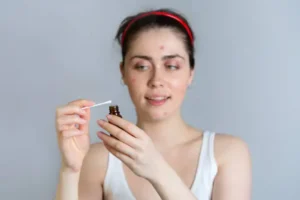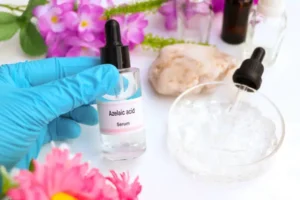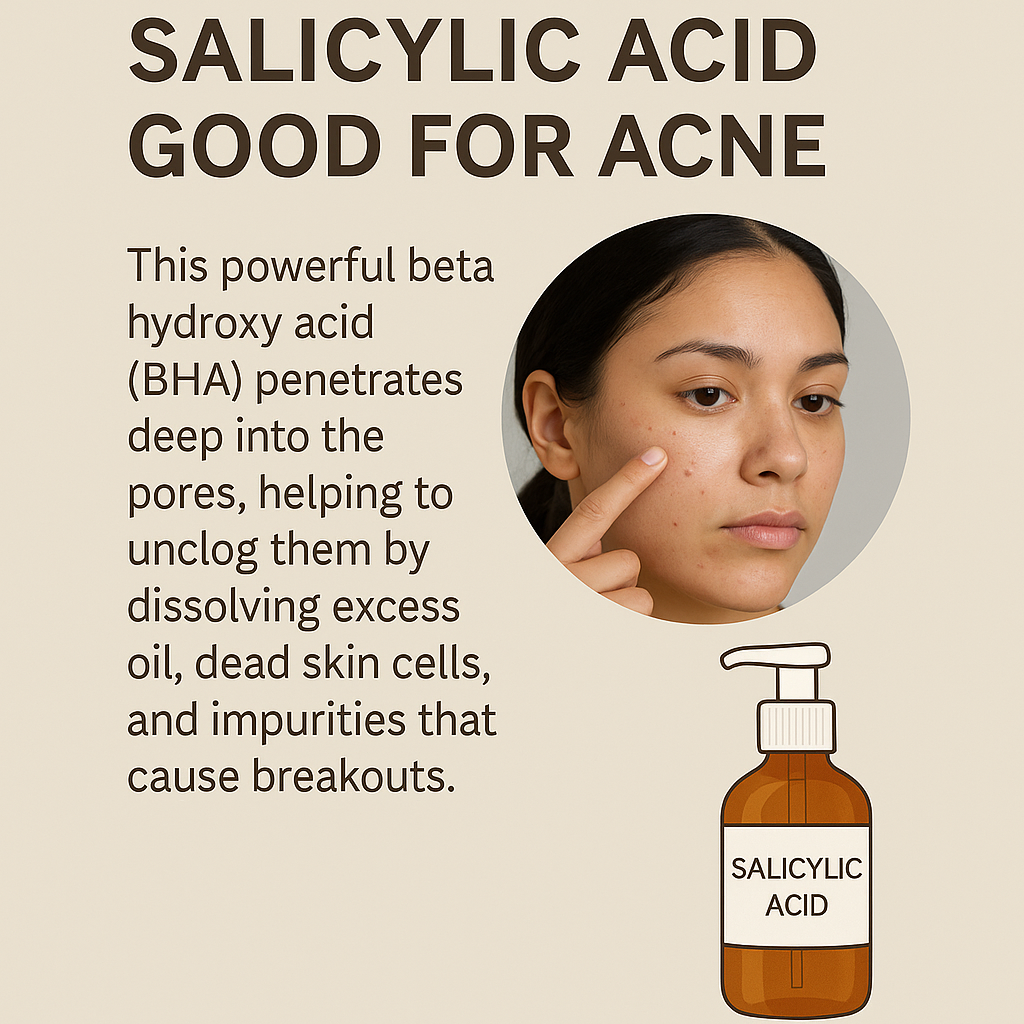Acne is one of those things that shows up uninvited and overstays its welcome. Whether you’re 15 or 35, the battle against pimples, blackheads, and oily skin feels never-ending. That’s where salicylic acid steps in as a popular solution. But does it work? Is it worth the hype? And how do you even use it without messing up your skin? Salicylic acid is good for acne
Let’s dig into everything you need to know about salicylic acid for acne—from how it works, who should (and shouldn’t) use it, and the best ways to make it part of your routine.
Understanding Salicylic Acid
What Is Salicylic Acid?
Salicylic acid is a beta-hydroxy acid (BHA), known for its ability to dive deep into your pores and break up all the junk that causes breakouts. It’s oil-soluble, which means it can cut through the sebum that clogs your pores. Unlike alpha-hydroxy acids (AHAs), which exfoliate on the surface, salicylic acid works beneath the skin.
Origins and Types
It was originally derived from willow bark, though most skincare products today use a lab-made version. Whether synthetic or natural, it offers the same acne-fighting benefits.
How It Works Chemically
It dissolves the glue that holds dead skin cells together, allowing them to shed easily, which unclogs your pores. Plus, it has anti-inflammatory properties that soothe irritated skin.
How Salicylic Acid Works Against Acne
Deep pore cleansing: It goes into your pores and clears out dirt, oil, and dead skin.
Prevents future breakouts: By keeping pores clean, you reduce the chances of new pimples forming.
Exfoliates skin: Gently removes surface skin to reveal fresh, smoother skin.
Calms inflammation: Reduces swelling, redness, and pain from active breakouts.
Types of Acne It Can Treat
Blackheads and Whiteheads
Salicylic acid is especially great for non-inflammatory acne, like blackheads and whiteheads. It clears out the gunk that causes them in the first place.
Mild Pustules and Papules
For small pimples without cystic activity, salicylic acid can shrink them quickly.
Hormonal Acne
While it won’t fix hormone imbalances, it can help manage the surface symptoms.
Benefits of Salicylic Acid for Acne
Clears clogged pores
Exfoliates dead skin
Reduces redness and irritation
Helps prevent future breakouts
Fades acne scars and pigmentation
Controls oil and shine
Salicylic Acid vs Other Acne Ingredients
Benzoyl Peroxide
Kills acne-causing bacteria but can be very drying. Salicylic acid is milder but doesn’t kill bacteria.
Glycolic Acid
An AHA that exfoliates on the surface but doesn’t clean deep inside pores like salicylic acid.
Retinol
Great for acne, but can cause intense purging and irritation. Salicylic acid is a gentler starting point.
Forms of Salicylic Acid Products
Cleansers – Daily use for oily skin types
Toners – Balance oil and remove residue
Serums – High concentration for targeted treatment
Spot treatments – Zap zits overnight
Masks – Deep clean once or twice a week
How to Use Salicylic Acid Safely
Start slow: 2–3 times a week, then work your way up.
Patch test: Always test a new product before using it on your full face.
Moisturize: Salicylic acid can be drying.
Sunscreen is a must: Your skin becomes more sensitive to UV rays.

Side Effects and Risks
Peeling or flaking skin
Redness and sensitivity
Potential over-drying, especially in winter
Irritation if overused or used with strong actives
Who Should Avoid Salicylic Acid?
Sensitive or extremely dry skin.
Pregnant or breastfeeding women – Check with a doctor first
People allergic to aspirin or salicylates
Combining Salicylic Acid with Other Ingredients
Niacinamide
Perfect duo – reduces inflammation and keeps skin calm.
Hyaluronic Acid
Restores moisture balance after using salicylic acid.
Avoid Mixing with:
Other exfoliants (AHA, BHA, retinol)
Vitamin C (unless recommended by a dermatologist)
Salicylic Acid for Body Acne
Acne isn’t just a facial problem. Salicylic acid works wonders for:
Back acne
Shoulder and chest breakouts
Butt acne
Use a salicylic acid body wash daily in the shower for best results.
Best Salicylic Acid Products in 2025
Budget-Friendly
The Ordinary 2% Salicylic Acid Solution
CeraVe SA Cleanser
Derm-Recommended
Paula’s Choice BHA Liquid Exfoliant
La Roche-Posay Effaclar Medicated Gel Cleanser
Natural Options
Herbivore Willow Bark Serum
Inkey List Beta Hydroxy Acid
Natural Alternatives to Salicylic Acid
Willow Bark Extract
Similar exfoliating properties with a gentler effect.
Tea Tree Oil
Fights bacteria and reduces redness naturally.
Zinc PCA
Regulates oil without stripping skin.

Long-Term Use: What to Expect
If you stick with salicylic acid:
Fewer breakouts over time
Reduced clogged pores
Smoother skin texture
But also: the need to stay consistent
Take occasional breaks to avoid skin fatigue.
Conclusion
So, is salicylic acid good for acne? Absolutely — if used correctly. It’s a proven ingredient that targets the root of breakouts by exfoliating dead skin, unclogging pores, and calming inflammation. Whether you’re dealing with blackheads, whiteheads, or the occasional pimple, salicylic acid can be your best skincare ally.
Just remember: consistency and patience are key. Start slow, pair it with calming ingredients, and always wear sunscreen!
FAQs
How long does it take for salicylic acid to clear acne?
It varies, but most people see improvements in 2–4 weeks with consistent use.
Can I use salicylic acid every day?
Yes, but start slowly and monitor your skin’s response. Daily use may cause dryness for sensitive skin.
Should I use salicylic acid in the morning or at night?
Night is usually better, especially if you’re using strong concentrations.
Is it okay to use salicylic acid with retinol?
It’s not recommended unless you’re an experienced user or under a dermatologist’s supervision.
Can salicylic acid make acne worse at first?
Some people experience purging – temporary breakouts as the skin clears out. It usually improves in 2–3 weeks.

